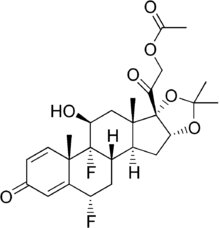- Fluocinonide
-
Fluocinonide 
Systematic (IUPAC) name 6α,9-difluoro-11β,16α,17,21-tetrahydroxypregna-1,4-diene-3,20-dione, cyclic 16,17-acetal with acetone,21-acetate Clinical data Trade names Lidex AHFS/Drugs.com Micromedex Detailed Consumer Information MedlinePlus a601054 Pregnancy cat. C Legal status Prescription Only (S4) (AU) POM (UK) ℞-only (US) Routes topical Pharmacokinetic data Metabolism hepatic Identifiers CAS number 356-12-7 ATC code C05AA11 D07AC08 PubChem CID 9642 DrugBank APRD00978 ChemSpider 9265 
UNII 2W4A77YPAN 
KEGG D00325 
ChEMBL CHEMBL1501 
Chemical data Formula C26H32F2O7 Mol. mass 494.525 g/mol SMILES eMolecules & PubChem  (what is this?) (verify)
(what is this?) (verify)Fluocinonide (Fluonex, Lidex, Lidex-E, Lonide, Lyderm, and Vanos)[1] is a potent glucocorticoid steroid used topically as anti-inflammatory agent for the treatment of skin disorders such as eczema and seborrhoeic dermatitis. It relieves itching, redness, dryness, crusting, scaling, inflammation, and discomfort.
The usual prescription concentration is 0.05% as a topical cream, ointment, or gel. The application area should normally not be covered after application. In certain cases, the physician may recommend the use of an occlusive dressing after application to increase the rate and depth of absorption. The frequency of application depends on the condition being treated and the area affected, but most often it should be applied twice a day.
Fluocinonide ranks as a "high-potency" (second-highest rank) topical corticosteroid. Minimal amounts should be used for a minimal length of time to avoid the occurrence of adverse effects.[2]
Fluocinonide should not be used if infection is present. It should not be applied to the eyes or to sensitive areas such as the genitals or anus.
A common potential adverse effect is skin atrophy (thinning of the skin). Systemic absorption of topical corticosteroids can produce reversible hypothalamic-pituitary-adrenal axis (HPA) suppression, manifestations of Cushing's syndrome, hyperglycemia, and glucosuria in some patients.
Fluocinonide should be used with caution when treating children, pregnant women, nursing mothers, and anyone using the medication for longer than two weeks.
Fluocinonide is used in veterinary medicine. It is a treatment for allergies in dogs.[3] Natural systemic cortisol concentrations can be suppressed for weeks after one week of topical exposure.[4]
References
- ^ MedlinePlus Drug Information: Fluocinonide Topical
- ^ Donald Y M Leung et al., "Disease management of atopic dermatitis: a practice parameter," Annals of Allergy, Asthma, & Immunology, Vol. 79, September 1997; http://www.jcaai.readyportal.net/file_depot/0-10000000/20000-30000/27387/folder/63948/Atopic_Derm1997.pdf
- ^ Dog Allergies www.squidoo.com/dogallergy
- ^ Zenoble RD, Kemppainen RJ, "Adrenocortical suppression by topically applied corticosteroids in healthy dogs." J Am Vet Med Assoc. 1987 Sep 15;191(6):685-8. http://www.ncbi.nlm.nih.gov/pubmed/2824410
Vasoprotectives (C05) Antihemorrhoidals for topical use corticosteroids (Hydrocortisone, Prednisolone, Betamethasone, Fluorometholone, Fluocortolone, Dexamethasone, Fluocinolone acetonide, Fluocinonide)
local anesthetics (Lidocaine, Tetracaine, Benzocaine, Cinchocaine, Procaine, Oxetacaine, Pramocaine)
other (Tribenoside)Antivaricose therapy heparins or heparinoids for topical use (Organo-heparinoid, Sodium apolate, Heparin, Pentosan polysulfate)
sclerosing agents for local injection (Monoethanolamine oleate, Polidocanol, Invert sugar, Sodium tetradecyl sulfate, Phenol)
other (Calcium dobesilate)Capillary stabilising agents bioflavonoids (Rutoside, Monoxerutin, Diosmin, Troxerutin, Hidrosmin) - other (Tribenoside, Etamsylate)Categories:- Glucocorticoids
- Organofluorides
- Acetate esters
Wikimedia Foundation. 2010.
